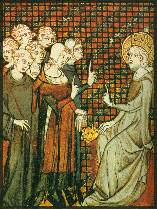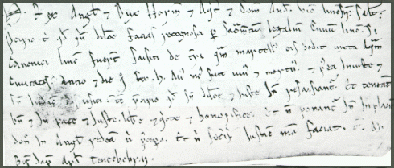
In England in Anglo-Saxon times (450-1066 AD) a system of law had developed which was based on oaths. This system continued into the 12th Century. The two sides in a case would each take an oath that what they said was the truth. Then others would swear oaths in support of one side or the other. Sometimes an accused person would be tested to see if they were telling the truth - for example by carrying a piece of red-hot iron for a certain distance. If their hands did not become infected but were starting to heal after three days, they were judged to be innocent. This is called trial by ordeal.
Another way of deciding was to have the two sides, accuser and accused, agree to fight one another - or have two champions fight on their behalf, as the two sisters of Noire Espine do. God would make sure, people thought, that the champion fighting for the side whose cause was just would win. This is trial by combat.
Unfortunately, it was often obvious that justice had not been done. King Louis IX of France (Saint Louis), who came to the throne in 1226, abolished trial by combat altogether. He insisted that the evidence brought by each side should be used to reach a judgement.

King Louis hearing law cases
In England King Henry II (1133-1189) encouraged the system of trial by a judge and twelve jurors rather than the old system of oaths and trial by ordeal or combat. These jurors ('jurati' means 'sworn men' in Latin) were worthy, local citizens, and they used their common sense and their knowledge of the people and events involved (evidence was still not considered the most important thing) to reach a verdict.

Henry II's order that some land should be given back to the Canons
(monks) of Lincoln, and telling the sheriff to find out the facts of the case.
By the 12th Century there were all kinds of courts: county courts, village courts, manor courts, Church courts, and so on. The court in which a person was tried depended on their position in society. Henry II did not try to get rid of these courts, but he tried to make the system simpler and make sure that they all kept to the same laws.
The Church courts were allowed to try anyone who was a member of the clergy (priests, monks etc.). As long as an accused person could recite certain Bible verses, they could claim what was called 'benefit of clergy' and be tried by a Church court. Since Church courts did not sentence anyone to death, a person might save his life by being able to say these verses, known as the 'halter verses' or 'neck verses' because of this.

A monk in the stocks being told off by a bishop
A person on the run could take shelter in a church or monastery. This was called claiming 'sanctuary', and they could not be arrested while inside for forty days - or in the case of some important churches, for life. While inside, they could agree to give themselves up for trial or to 'abjure the realm' (this meant they must confess to their crimes and promise to leave the country).